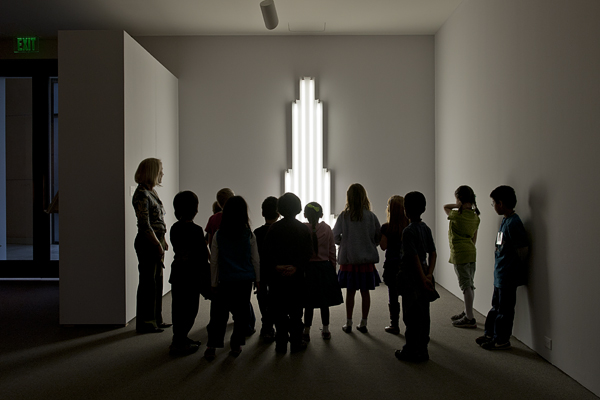Interpreting an artist's intent involves a team of experts at Stanford's Cantor Arts Center
Staying true to the artist and the artwork is at the heart of each decision made by museum curators, conservators and preparators while installing works by Dan Flavin and Robert Irwin.
How do you light a work of light? The staff at the Cantor Arts Center at Stanford University faced that dilemma earlier this month when they installed the two large works that comprise Light Works: Dan Flavin and Robert Irwin. It took a team of experts three days to feel like they got it right.
Artists don't always provide installation instructions for their work, and if they do, there are still a lot of variables to manage with each presentation, and much of the written word is left to interpretation. Museum professionals use artist's notes the way actors follow stage directions: to recreate what the artist intended. With visual art, the wall color, height, location within the gallery and lighting all contribute to the viewers' experience. What was he thinking? is not just a rhetorical question but a line of inquiry that can guide the museum staff as they approach a work of art.
The Cantor experts used written instructions for the Irwin work, and an awareness of earlier installations of both pieces, to guide them through Light Works, but good ol'-fashioned trial and error proved to be just as important.
Flavin and Irwin both employed electric light in their work. Flavin's "monument" for V. Tatlin (1969) is a representative example of the artist's use of mass-produced fluorescent light. It is characteristic of the industrial materials preferred by New York Minimalists such as Carl Andre and Donald Judd. Ideally, the frameless "monument" of electric light is allowed to define a space and blaze free of distraction.
The untitled disc from 1967 by Irwin typifies the interest in light and space that occupied a number of artists working in Los Angeles in the 1960s. When installed correctly, the disc seems to float. The effect is caused by a number of physiological factors, including sensitivity to contrast. But it's also the result of a really good light bulb: a 65-watt GE Reveal.
One work of art emanates searing white light and the other hovers in warm light and shadow. The trick is giving each work enough space while encouraging a visual dialogue.
Ray Madarang, the museum preparator working on the Light Works installation, followed Irwin's written instructions for installing the disc, but also had to factor in the unique conditions of the Halperin Gallery. Even though the artist wrote that ambient light was a necessary element to the success of the artwork, once both artists' pieces were installed the light that was washing over from the Flavin was too aggressive and harsh. "It conflicted with the subtle atmospheric lighting that was called for within the Irwin's space," Madarang said. "We had to find a way to mitigate this conflict between the spaces. Two or three days before the opening we extended an existing wall to contain the Flavin."
The divide between the two works allows them to coexist as neighbors without compromising the artists' intent or viewers' perception.
Contributing to the team of installation experts was Brian Isobe, a matting and framing preparator and one-time student of Irwin's. In an attempt to get into Irwin's head for this project, he recalled the seminar he took with the artist and consulted the bible of reference books on Irwin's work, Seeing Is Forgetting The Name Of The Thing One Sees by Lawrence Weschler.
"Irwin made me realize that art doesn't exist within the rectangle of the canvas. Ambiguity is welcomed and the entire room becomes the piece, not just the disc itself," Isobe said. With this in mind, the museum lighting and the painted object became equally important elements. The team experimented with different light bulbs and filters as well as distance and intensity to achieve an ethereal light casting perfectly balanced petal shadows around the disc.
Conservators are just as invested in understanding the artist's intent with their work and the installation. Susan Roberts-Manganelli, the manager of collections, exhibitions and conservation, weighed in as a third expert of the Light Works brain trust. She notes that end caps, coatings and other materials making up fluorescent lightbulbs such as the ones Flavin used have changed over time and emit different colored light than the bulbs used in the original artwork, giving the installation a different look.
"Fluorescent lights can have a long life, especially when turned on for the limited time of an exhibition. But eventually they burn out. By measuring the wavelengths emitted by Flavin's original bulbs, conservators and curators can know the artist's original light palette, and by keeping a data bank can possibly try to find ways to replicate it in the future when the bulbs no longer function," she said.
Hilarie Faberman, the curator of modern and contemporary art at the Cantor, headed the team of experts. She was delighted with the results. "We showed the Irwin in 1999 but I wasn't happy with the way it looked. Pairing it with the Flavin, on loan from the Fisher Family, gave us another shot at the installation and I think we got it right this time."
These two works, on view through July 8, complement Wood, Metal, Paint: Sculpture from the Fisher Collection, also at the Cantor, and provide another look at the diverse artistic approaches of the 1960s.
Media Contact
Anna Koster, Cantor Arts Center: (650) 725-4657, akoster@stanford.edu
Robin Wander, Stanford News Service: (650) 724-6184, robin.wander@stanford.edu


Share This Story